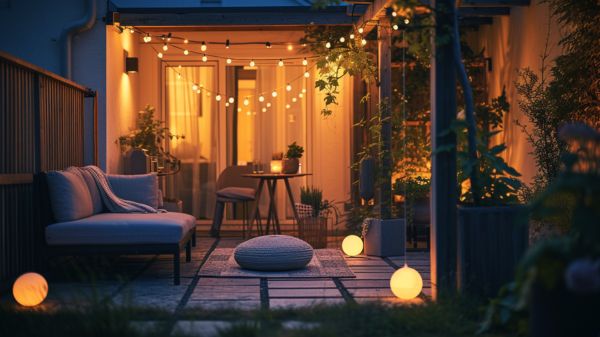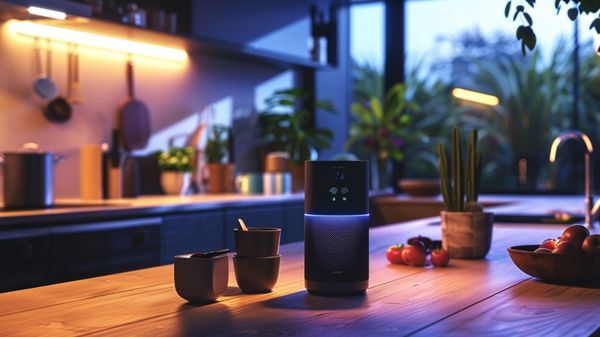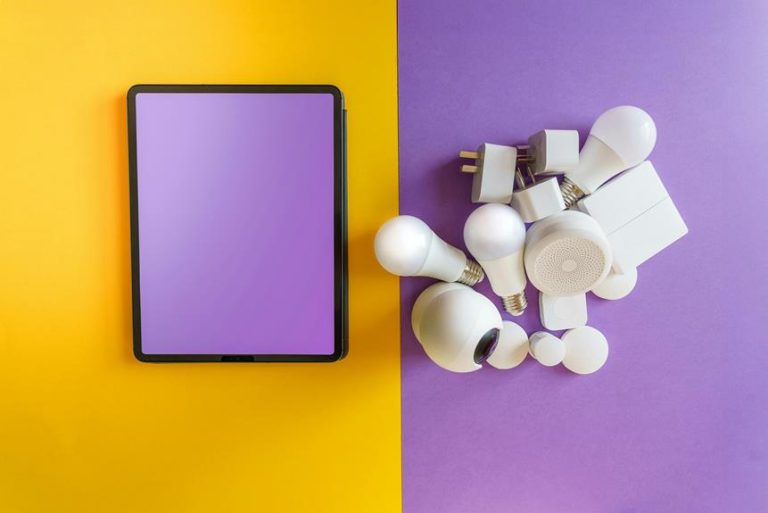As we explore the domain of energy conservation, LED bulbs stand out due to their efficiency and potential for considerable utility savings. While the initial switch to LED lighting is a recognized step towards reducing energy consumption, optimizing these benefits involves more than mere replacement of incandescent bulbs.
Strategies such as integrating dimmable LEDs, employing smart lighting technologies, and thoughtful placement can greatly enhance energy savings. However, to fully leverage the capabilities of LED technology, it is essential to take into account additional factors that contribute to their energy-efficient performance.
What could these factors be, and how might they further transform our approach to sustainable lighting? Let’s explore and find out!
Understanding LED Lifespan Benefits
Why should consumers consider LED bulbs?
Primarily, their remarkable lifespan of over 100,000 hours markedly surpasses that of traditional incandescent bulbs, offering substantial economic and environmental benefits. By outlasting traditional bulbs by a factor of up to 25 times, LEDs present a compelling case for those seeking liberation from frequent replacements and high maintenance costs.
This extended lifespan directly translates into significant cost savings. Considering the average usage, the need to purchase and replace traditional bulbs more frequently accumulates higher expenses over time.
In contrast, the initial higher cost of LED bulbs is offset by their durability and lower operational costs. Furthermore, the reduced frequency of replacements means less waste generated and fewer resources expended on manufacturing, packaging, and transporting new bulbs.
For consumers and businesses alike, the switch to LED technology not only promises a reduction in immediate overheads but also contributes to a broader commitment to environmental stewardship. The longevity of LED bulbs reduces the demand on resources and minimizes the volume of waste, aligning with sustainable practices and offering a practical solution to energy conservation challenges.
This makes LEDs an essential component of energy-efficient and cost-effective lighting strategies.
Exploring Small Size Advantages
The compact size of LED bulbs offers considerable flexibility in installation and application, enabling them to be utilized in spaces where traditional lighting solutions are impractical.
This small form factor not only facilitates easy placement in tight or unique spaces but also enhances lighting efficiency by minimizing physical obstructions, thereby maximizing the utilization of light output. Consequently, LED bulbs are an essential component in energy-efficient lighting strategies, particularly in environments where space enhancement is critical.
The versatility of LED bulbs is further evidenced in their reduced need for bulky fixtures, which supports a minimalist and modern aesthetic while contributing to significant energy savings. This space-saving characteristic is particularly advantageous in design and architecture, allowing for cleaner lines and less visually intrusive lighting solutions.
Here is an overview of the benefits of the small size of LED bulbs:
| Benefit | Description | Impact on Energy Savings |
|---|---|---|
| Versatile Placement | Fits in unconventional areas | Reduces wasted lighting |
| Minimal Fixtures | Less material used, streamlined design | Lower energy consumption |
| Reduced Maintenance | Fewer replacements due to efficient placement | Long-term cost savings |
These attributes underscore the practical and liberating aspects of LED technology in modern energy-efficient lighting solutions.
Related Post: The Best Solar-Powered LED Light Bulb for Sustainable Illumination.
Advantages of Directional Emissions
The directional emission of LED bulbs primarily enhances focus efficiency by directing light precisely where it is needed, considerably reducing scatter and redundancy in illumination.
This targeted approach not only conserves energy but also increases the efficacy of lighting systems in both residential and commercial settings.
Enhancing Focus Efficiency
LED bulbs stand out for their ability to emit light directionally across a 180-degree angle, which greatly enhances focus efficiency by targeting illumination precisely where it is needed.
This characteristic of LED technology plays a critical role in optimizing energy efficiency and effective lighting in both residential and commercial settings. By concentrating light directly on specific areas without dispersal, LEDs not only save money on energy costs but also enhance focus, making them ideal for environments requiring precision and clarity.
- Targeted Illumination: LED bulbs focus light exactly where it is most needed, avoiding wastage and improving visibility in designated areas.
- Reduced Installation Costs: The elimination of additional reflectors and diffusers cuts down on installation complexities and expenses.
- Energy Savings: By minimizing wasted light, LEDs can achieve up to a 75% reduction in energy use compared to traditional lighting, promoting substantial cost savings.
- Enhanced Productivity: Focused lighting improves task performance by reducing glare and increasing concentration, which is particularly valuable in workspace environments.
These advantages make LED bulbs a smart choice for anyone looking to enhance lighting efficiency and embrace energy liberation.
Reducing Light Scatter
Building on their capacity for targeted illumination, LED bulbs further conserve energy by emitting light within a focused 180-degree angle, effectively reducing scatter and enhancing lighting precision. This directional emission is pivotal for attaining high lighting efficiency as it channels light directly to desired zones, avoiding the unnecessary diffusion that is common with traditional lighting solutions.
LEDs inherently minimize the need for auxiliary lighting components such as reflectors and diffusers, which are often required in conventional fixtures to manage light scatter. By eliminating these components, LEDs not only streamline the design but also cut down on operational costs and material waste, contributing to a leaner, more energy-efficient lighting system. This reduction in peripheral devices directly translates to lower electricity consumption and reduced environmental impact.
Moreover, the precise control over light direction afforded by LEDs allows for strategic placement in environments requiring focused illumination. This capability guarantees that light is not wasted on areas that do not require it, thereby maximizing energy savings.
The practical implementation of directed LED lighting consequently supports a sustainable reduction in energy usage, aligning with the goals of users seeking effective, cost-efficient, and environmentally friendly lighting solutions.
Durability of LED Lights
How does the solid-state construction of LED lights enhance their durability compared to traditional bulbs?
LED lights, known for their resilience, leverage solid-state technology which considerably fortifies them against common damages that often plague incandescent and CFL bulbs. This inherent robustness is a cornerstone in reducing both energy and maintenance costs, making LED lights a superior choice for those seeking a dependable lighting solution.
The durability of LED lights is not just a technical advantage but a practical liberation for users who prioritize reliability and efficiency.
Reflect on the following points:
- Extended Lifespan: LEDs outshine traditional bulbs with a lifespan that can exceed 100,000 hours, which slashes the frequency of replacements.
- Lower Maintenance Costs: The longevity of LEDs minimizes the need for frequent maintenance, thereby reducing ongoing costs and hassle.
- Resistance to Impact: Unlike fragile incandescent bulbs, LEDs are tough against physical impacts and vibrations, enhancing their usability in various settings.
- Cost Efficiency: Fewer replacements mean fewer expenses. The durability of LED lights leads to substantial savings on both energy and replacement costs.
This resilience of LED lights guarantees they remain a cornerstone in energy-efficient and cost-effective lighting technologies.
Energy Efficiency Features
LED bulbs not only offer significant reductions in energy consumption due to their high efficiency but also integrate seamlessly with smart lighting systems to optimize energy usage.
Maximizing LED usage involves strategic placement and selection of appropriate wattage to match specific needs while reducing excess lighting.
Integrating smart technology allows for automated adjustments based on real-time environmental data, further enhancing the energy-saving potential of LED lighting solutions.
Maximizing LED Usage
To maximize the energy efficiency of LED bulbs, it is crucial to leverage their directional lighting, dimming capabilities, and compatibility with automated controls. LED light bulbs are at the forefront of energy savings and lighting efficiency due to their advanced technology.
Users can considerably reduce electricity usage and costs by optimizing these features. The long lifespan of LEDs also diminishes the frequency of replacements, further enhancing their economic and environmental appeal. Here are practical ways to maximize the use of LED bulbs:
- Opt for LEDs with adjustable beam angles to focus light exactly where it is needed, preventing wastage and improving area-specific illumination.
- Utilize dimming capabilities to adjust the light intensity according to the time of day or activity, which can greatly lower power consumption.
- Replace all incandescent bulbs with LEDs in both indoor and outdoor settings to harness full-scale energy savings.
- Regularly clean LED fixtures to maintain peak brightness and efficiency, as dust and debris can reduce effectiveness.
Implementing these strategies will guarantee that the benefits of LED technology are fully realized, promoting both energy conservation and cost-effectiveness.
Smart Lighting Integration
Integrating smart lighting systems with LED bulbs enhances energy efficiency by automating control over lighting based on occupancy and time variables. By deploying motion sensors and smart thermostats, these systems guarantee that lighting is used effectively only when necessary, greatly curtailing energy wastage. The ability to dim lights according to the available natural light or specific user settings also contributes to considerable energy savings.
Monitoring and controlling these settings through smart home apps not only provides convenience but also empowers users with real-time data to make informed decisions about their energy usage. This integration represents a practical solution that leverages technical expertise to meet the energy conservation needs of an audience seeking liberation from high power costs and environmental impact.
| Feature | Benefit |
|---|---|
| Automated Scheduling | Reduces energy usage during low occupancy |
| Dimming Capabilities | Adjusts brightness to save energy |
| Motion Sensors | Activates lights only when necessary |
| Coordinated Management | Syncs with other smart home systems |
Adopting smart lighting systems integrated with LED bulbs is a strategic move towards achieving effective energy efficiency and sustainability, offering users control and flexibility in their consumption patterns.
Dimming Capabilities of LEDs
Adjustable brightness levels in LED bulbs not only enhance user customization but also contribute greatly to energy savings and bulb longevity.
The dimming capabilities of LEDs allow for efficient power operation, which is vital for both reducing electricity costs and minimizing environmental impact. By using compatible dimmer switches, users can guarantee that their LED bulbs perform at peak efficiency, avoiding issues like flickering or reduced lifespan which can detract from the overall benefits of LED lighting.
Key points to take into account include:
- Energy Efficiency: Dimming LEDs can save 20-30% more energy compared to non-dimmable LEDs by using less power at lower brightness levels.
- Extended Lifespan: LEDs operated at dimmed levels experience less heat stress, thereby extending their operational life.
- Enhanced Comfort: Smooth dimming technology in LEDs prevents the flickering that can cause discomfort and eye strain.
- Compatibility: Confirming that dimmer switches are specifically designed for LED technology maximizes efficiency and performance.
Safety Aspects of LED Lighting
LED lighting is leading for its safety features, which enhances by its low heat generation and durable construction.
Compared to traditional lighting, LED bulbs produce considerably less heat, diminishing the risk of heat-related accidents and fire hazards. This attribute not only makes LEDs a safer choice for both residential and commercial environments but also contributes to energy conservation, as the minimal heat output requires less cooling in spaces, further saving on energy costs.
The solid-state construction of LED lights inherently enhances their safety by making them resistant to breakage. Unlike traditional bulbs, LEDs are less likely to shatter upon impact, reducing the risk of injuries from broken glass. This durability also means that LEDs are more reliable in various applications, from industrial settings to everyday home use.
Moreover, LEDs do not contain hazardous materials such as mercury, which is prevalent in fluorescent lamps. This absence of toxic elements makes LED lighting a safer and more environmentally friendly option, facilitating safe disposal and handling.
Their instant on/off capability further guarantees safety by providing immediate illumination, essential for avoiding accidents in sudden low-light conditions. Consequently, LED lighting offers a liberated approach to safe, efficient, and conscientious energy use.
Color Rendering Index Explained
Building on the attributes of LED lighting, the Color Rendering Index (CRI) is an essential metric that evaluates a light source’s capacity to display colors faithfully in comparison to natural light. This measure is pivotal in appraising the quality of lighting technology, particularly when examining the efficiency and performance of LED bulbs. A higher CRI is indicative of a light source’s ability to produce a spectrum of colors that are vibrant and true to their natural appearance.
Key Points Regarding Color Rendering Index:
- High CRI LEDs Enhance Visual Clarity: With a CRI often above 80, LED bulbs guarantee colors looks more clearly and accurately, reducing the strain on the eyes and enhancing visual comfort.
- Energy Efficiency: LEDs convert more energy into light rather than heat, which means a good quality LED with a high CRI is also more energy-efficient.
- Improved Aesthetics: Spaces illuminated by high CRI LEDs are visually appealing, making them ideal for venues that require precise color differentiation like galleries and retail stores.
- Cost-Effective: By improving the quality of light, high CRI LEDs reduce the need for additional lighting fixtures.
This combination of utility and efficiency makes LEDs equipped with a high CRI an indispensable tool in advanced lighting solutions.
Conclusion
To sum up, LED bulbs present a formidable solution for energy conservation in lighting. Their extended lifespan, compact size, and directional light emission enhance their efficiency and application versatility.
The inherent durability and superior energy efficiency of LEDs not only reduce maintenance costs but also contribute to significant energy savings. Additionally, their dimming capabilities and high color rendering index make them a safe and aesthetically pleasing option, underscoring their role as a cornerstone in sustainable lighting technology.




